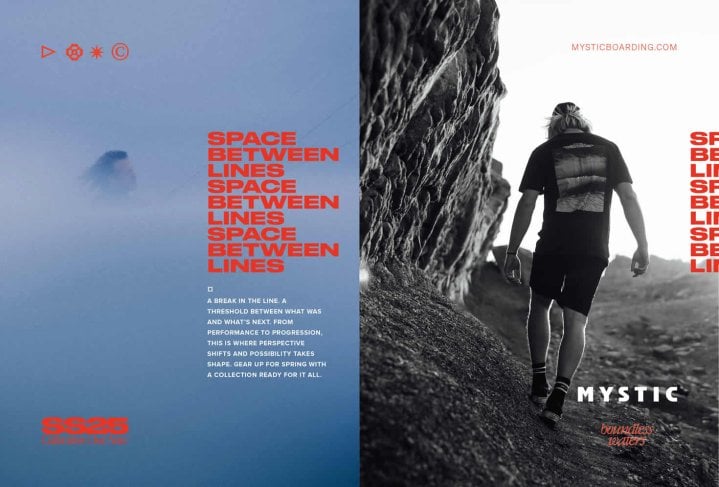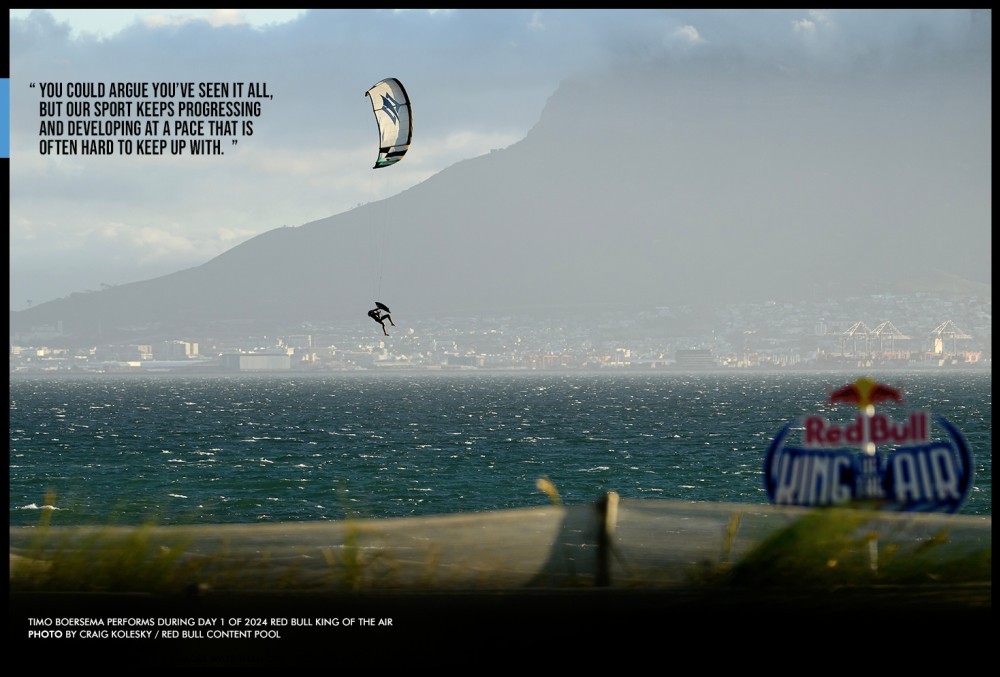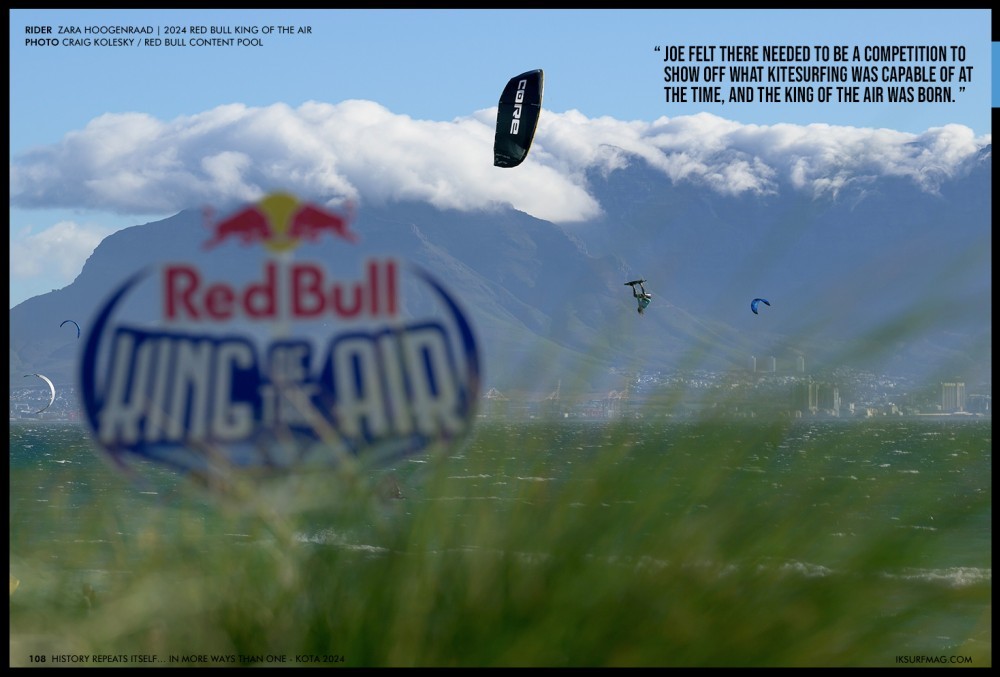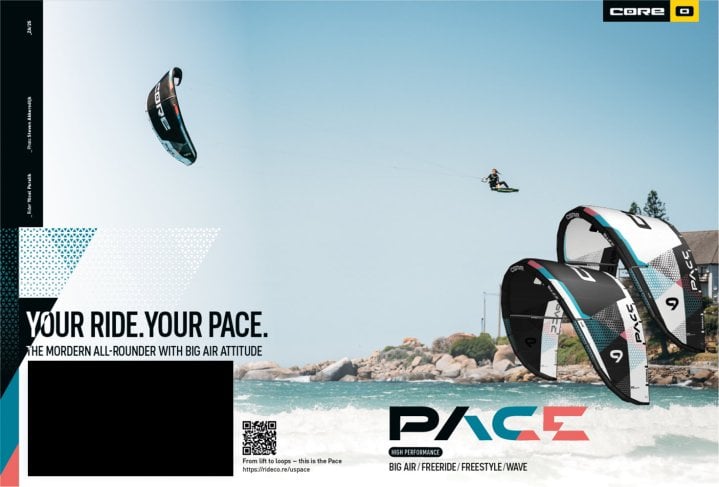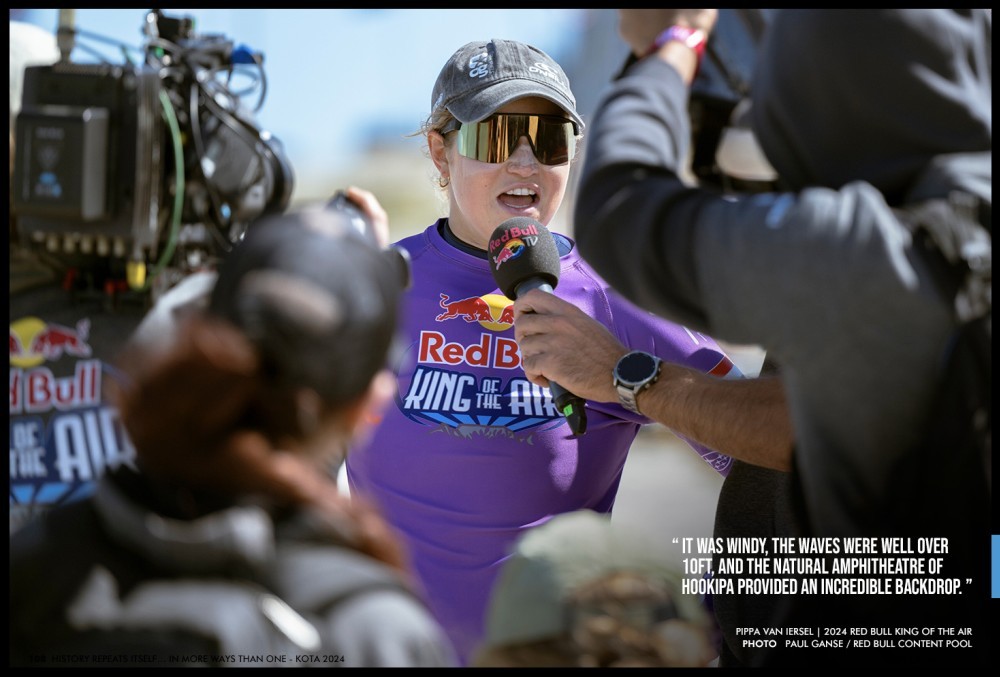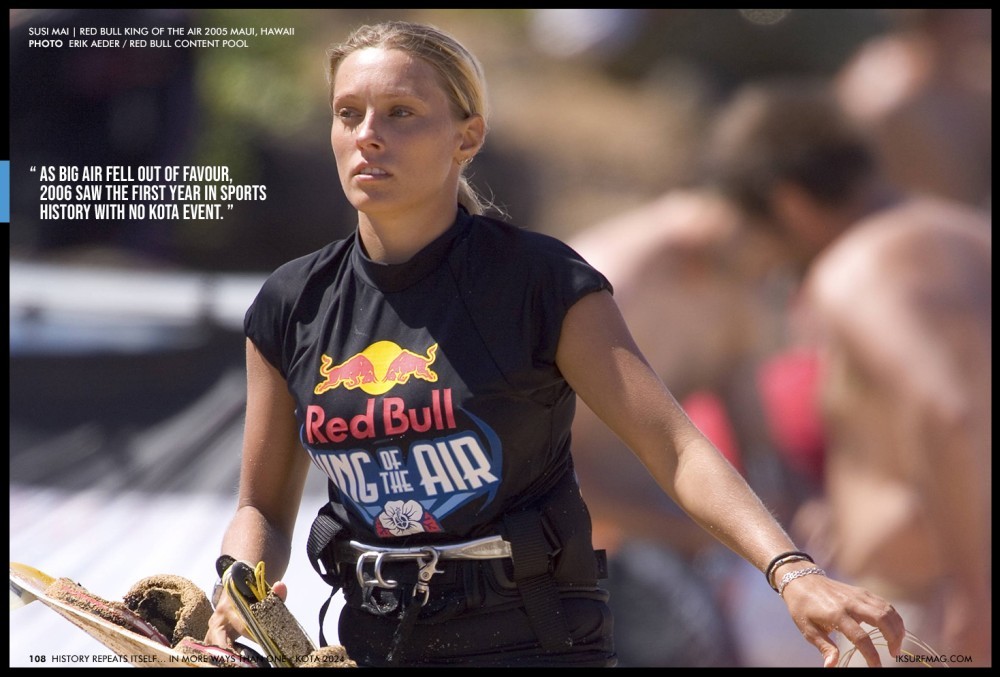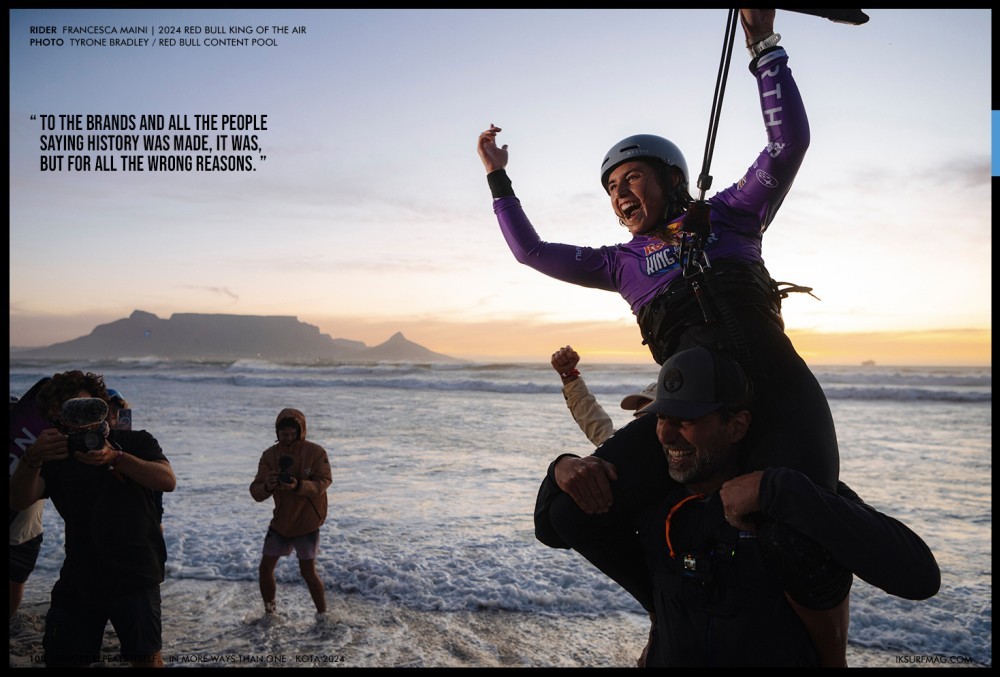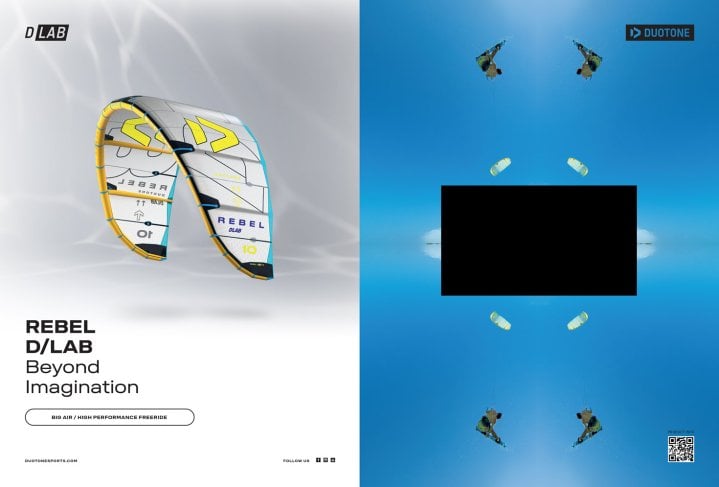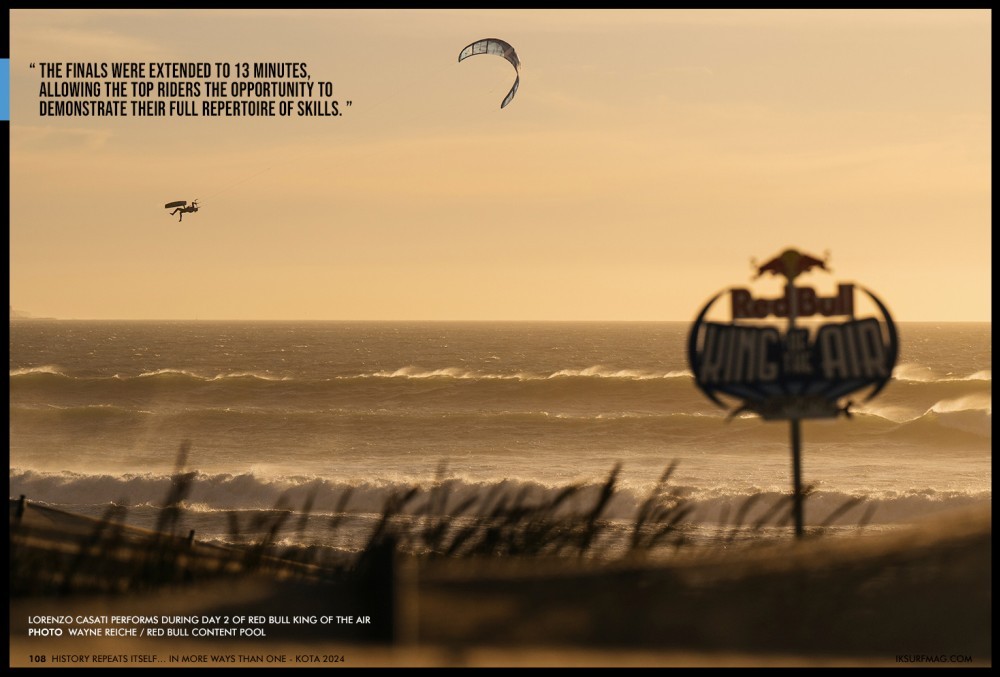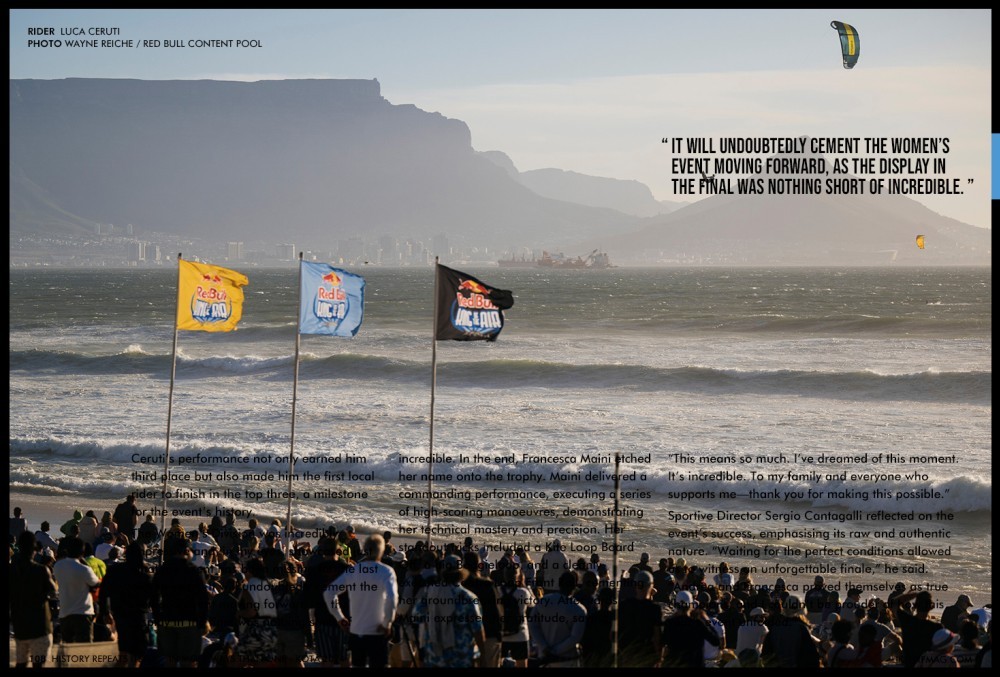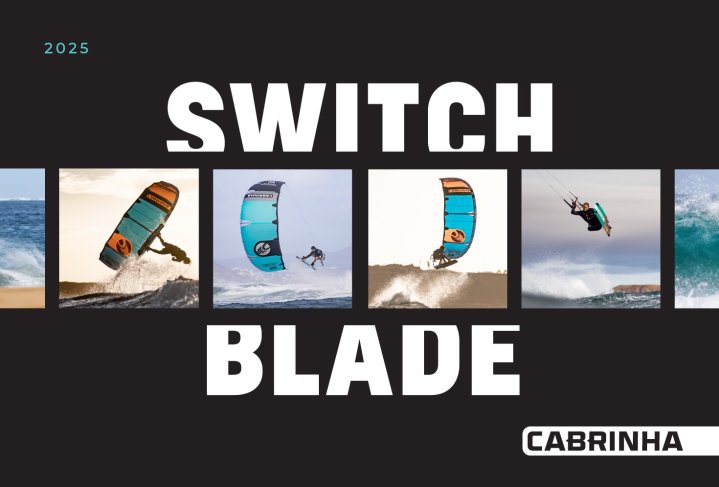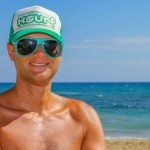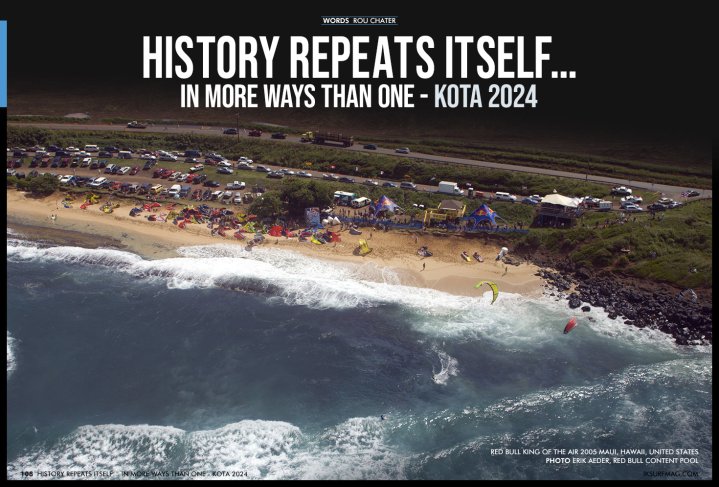
History Repeats Itself… In more ways than one - KOTA 2024
Issue 108 / Tue 17th Dec, 2024
Kiteboarding might be a young sport, but its history is packed with unforgettable moments. This year’s Red Bull King of the Air wasn’t just about going extreme —it was also a chance to reflect on where the sport started and how far it’s come. Rou Chater, who’s been in the game for 25 years, shares his unique take on KOTA’s evolution, from its roots in Maui to the groundbreaking inclusion of a women’s division this year. Get ready for a deep dive into the event’s history, the highs and lows, and what makes it such a massive part of the kiteboarding culture.
They say history always repeats itself, proven repeatedly over the centuries. With such a young sport like kitesurfing, we don’t have to look too far back to see the Big Bang moment. For twenty-five years, we’ve been trailblazing the most addictive sport ever invented, and I’ve been lucky enough to watch it unfold before my own eyes.
Having a storied 25-year history within the sport gives one a certain perspective. You could argue you’ve seen it all, but our sport keeps progressing and developing at a pace that is often hard to keep up with. What was interesting for this year’s KOTA was seeing how many brands and riders talked about history being made, which was interesting to me.
If you look at the history of the KOTA, you’d be forgiven for thinking it was born in 2013 in Cape Town. The modern version of this event did indeed start then, and the history everyone was talking about at this year’s event was finally, after nearly ten years, there would be a “women’s division.”
It’s great that this happened, but I have two major issues with it. First, why has it taken ten years for the organisers to recognise that women kitesurf, too, in a sport and era meant to be all about equality?
Secondly, this was championed as history in the making… No matter how hard you search, you’ll get a thin sentence stating the KOTA started in Hawaii in the early 2000s, and that’s about it.
I was asked why there is no information online about this, and it’s easy to forget that 20 years ago, we didn’t have the Internet like we do today. Back in the early 2000s, the print media was king, websites were not really popular, and social media was just a twinkle in Zuckerberg’s nutsack.
There is a history of these events in the printed media of the time and in the memories of those who were there… I was one of those people. I was lucky enough to attend the last ever King Of The Air on Maui, and it ended because while big air had been the pinnacle of the sport up to that point, it was being eclipsed by freestyle as a discipline.
Indeed, for a fair while, from circa 2005 onwards, any trick where you sent the kite for height was frowned upon. Big air had had its day. So, for the uninitiated and those who thought history was made last weekend, here’s a short update before we get into the meat and bones of this year’s event.
King Of The Air started in 2000 in Maui. Joe Koehl (pronounced and often misspelt as Joe Cool) dreamt up the concept. Joe was a sail designer in Maui and introduced many of the sport’s early names. Joe was a key face within the sport at its inception in 1998. In addition to designing and making kites, he also organised events and helped produce some of the first kitesurfing movies ever filmed.
In 2000, Joe felt there needed to be a competition to show off what kitesurfing was capable of at the time, and the King Of The Air was born. What is key is that this event ran for five years, grew, and developed into a worldwide phenomenon. It had qualifiers around the world, and people competed to win a ticket to the finals in Hawaii.
The event was held at the hallowed Hookipa Beach Park, a spot that had banned kitesurfing as it’s a windsurfing Mecca. It allowed kiters to kitesurf at Hookipa and show off their skills to the crowds and international media.
To give you an idea, when I went to the final event in 2005, I was accompanied from the UK by a plethora of journalists as well as a TV film crew. This wasn’t for the event itself but to record it for the magazines and TV companies we all worked for. Journalists from broadsheets like the Times Newspaper, national women’s magazines, and a film crew Channel 4 give you a flavour of what I mean.
If you are an international reader, Channel 4 was one of the only four terrestrial stations in the UK. The Times is arguably one of the world’s biggest, most established and longest-running newspapers. We also had journalists from women’s magazines; I think it was called “Chat” or something like that, but it had a circulation in the millions of UK women.
The last word of that sentence is key. For the five years that the King Of The Air had been in existence, there had ALWAYS been a Queen Of The Air, too. For whatever reason, this fact seems to have been lost in the sands of time, and finding any mention of it is near impossible. I was there; it happened…
That particular King Of The Air was incredible. It was windy, the waves were well over 10ft, and the natural amphitheatre of Hookipa provided an incredible backdrop. It also marked the change of guard, as long-time winner of the event and local hero Robby Naish was defeated by a very young Ruben Lenten in the final. Newskool was taking over, I recall writing at the time. A young Aaron Hadlow was also there, well on his way to total world domination of the competitive sphere of kiteboarding.
More importantly, a stacked women’s fleet was competing for the crown, too. Audrey Meyer was duking it out with some of the local girls as well as kitesurfing’s hottest property, Susi Mai. Hailing from Germany, Susi was arguably the most famous face of the sport back then. A rare talent, she had the old school and new school locked down and was always a pleasure to watch on the water.
Susi Mai won and was crowned the Queen Of The Air.
This fact has always baffled me. As big air fell out of favour, 2006 saw the first year in sports history with no KOTA event. No king and no queen were crowned, and this was the case for the next eight years…
In 2013, the KOTA was reborn, and big air kitesurfing was experiencing a renaissance, although it was still rather niche and not the behemoth that it is now. Ruben Lenten had been storm chasing since 2006, and something that he had used to do alone had gradually become a “thing” and enough of a thing to get a bunch of pros together and make an event out of it.
Regardless of what happened this year, I think it’s a stain on our sport that we never had a Queen Of The Air event in 2013. We did it for 2000, 2001, 2002, 2003, 2004 and 2005, so what’s the excuse for 2013 and onwards until 2024? I’ve not heard a good one; there were more female kiters in 2013 than ever, and the women’s side of the sport has been growing alarmingly. It’s a shame that kiteboarding’s largest showcase never recognised that.
So it’s great that this year there was finally a women’s division, but it is noted that there is no mention of a Queen Of The Air title anywhere, heck I got one press release that the women would be competing for a Queen of Hearts title. Jesus, what the f**k is that? Can things get any more condescending? The guys are Kings Of The Air, and the girls are queens of our hearts for going out there and giving it a go???
It’s embarrassing, and thankfully, aside from this one press release, it was never mentioned again. To the brands and all the people saying history was made, it was, but for all the wrong reasons. Let’s not forget the history that went before.
Kudos for finally having a women’s division, but it wasn’t a historical first. There is a massive black mark for taking a mere eleven years to recognise the women who enjoy our sport and a bigger black mark for not making them the Queens of The Air. Our sport should be based on equality and not misogyny.
Anyway, rant over. Let’s recap what went down in Blouberg this year. It was an interesting event in many ways. The Cape Doctor was absent for large parts of the holding period. Indeed, it was the first year in the event’s recent history when there was real talk of not being able to finish the competition.
The light winds of the first day certainly challenged all the riders involved, but the event team made all the right calls and did the best they could with the dice they were dealt. Of course, we all want to see a 40knot plus mega blaster kick in at midday, and the records are broken, but we’ll settle for anything when the forecast is so bad!
The two-week event holding window is tricky for organisers; a lot of infrastructure needs to be put in place for the period, and all the staff have to be on standby to drop everything off and get to the event when the forecast gives the green light. That’s expensive and stressful. The event used to be held in early February before COVID-19, but it was shifted to the end of November and has remained so for the last few years.
Usually, Cape Town will allow you to bet the house on wind, but this season has been worse than usual. So, a big thumbs up to all involved for getting day one out of the way and for holding the nerve to hope the wind filled in on Sunday, the last day of the event window.
As the day started to unfold, the tension was palpable. Would the wind kick in? Would there be enough time to get through all the remaining heats? Would there be a prize giving? To be fair, the organisers played a blinder. They adjusted the format, shortening heats and breaks to make the most of the rather tardy conditions.
The famed Cape Doctor winds finally peaked at 40 knots late in the afternoon, but the huge 2.5—to 3.1-meter southwest swells were there all day to create a huge challenge for the riders and an incredible spectacle for everyone on the beach. Heats were reduced from ten minutes to eight to maintain the intensity, with brief intervals between rounds. The finals were extended to 13 minutes, allowing the top riders the opportunity to demonstrate their full repertoire of skills.
In the Open Division final, riders pushed the limits of the sport, performing in near darkness to solidify the event’s reputation as the pinnacle of Big Air kiteboarding. Andrea Principi rose to the occasion, showcasing why he remains at the top of the sport. His standout tricks included a Contra Loop Back Tornado Board Off, which earned 7.18 points, a stylish Doobie Loop Board Off, scoring 6.76 points, and a technical Contra Loop Double Front Roll Rodeo that added another 6.47 points to his tally. This combination of height, precision, and innovation secured his second consecutive title. Reflecting on his victory, the 20-year-old said, “Once may be luck, but this feels incredible. Honestly, I’m not the real winner here—my family and sponsors are the true champions. They make this possible, and I owe them everything.”
Principi was joined on the podium by his compatriot Lorenzo Casati, who claimed second place, while South African rider Luca Ceruti impressed the home crowd. Ceruti’s performance not only earned him third place but also made him the first local rider to finish in the top three, a milestone for the event’s history.
The Women’s Division was incredibly impressive and, in my eyes, showcased just what the event has been missing for the last eleven years. It will undoubtedly cement the women’s event moving forward, as the display in the final was nothing short of incredible. In the end, Francesca Maini etched her name onto the trophy. Maini delivered a commanding performance, executing a series of high-scoring manoeuvres, demonstrating her technical mastery and precision. Her standout tricks included a Kite Loop Board Off, a big Boogieloop, and a cleanly executed Contra Loop Front Roll, cementing her groundbreaking victory. Afterwards, Maini expressed her gratitude, saying, “This means so much. I’ve dreamed of this moment. It’s incredible. To my family and everyone who supports me—thank you for making this possible.”
Sportive Director Sergio Cantagalli reflected on the event’s success, emphasising its raw and authentic nature. “Waiting for the perfect conditions allowed us to witness an unforgettable finale,” he said. “Andrea and Francesca proved themselves as true champions, and I couldn’t be prouder of how this year’s event unfolded.”
As always, the Mystic Move of the Day is a hotly contested wildcard trophy that encourages the riders to really push the limits. This year, American teenager Zac Adams took the trophy for his innovative Kiteloop Rotational Boardflip in Round 1. Watching it left you with your heart in your mouth, and when he caught it, you felt yourself punching the air with him.
With this year’s unforgettable performances setting the bar high, the 2025 edition promises even more excitement, featuring three European qualifiers before the world final returns to Cape Town.
Let's just hope that after so long in the dark ages in terms of equality, the inclusion of the women’s division sets a precedent moving forward. As shameful as I find the past, you can’t help but get excited about this event, and now, with the girls inspiring women all over the world, it’s become a lot more special.
Open Division
- Andrea Principi (Italy)
- Lorenzo Casati (Italy)
- Luca Ceruti (South Africa)
Women’s Division
- Francesca Maini (United Kingdom)
- Zara Hoogenraad (Netherlands)
- Pippa Van Iersel (Netherlands)
Videos
By Rou Chater
Rou has been kiting since the sports inception and has been working as an editor and tester for magazines since 2004. He started IKSURFMAG with his brother in 2006 and has tested hundreds of different kites and travelled all over the world to kitesurf. He's a walking encyclopedia of all things kite and is just as passionate about the sport today as he was when he first started!


